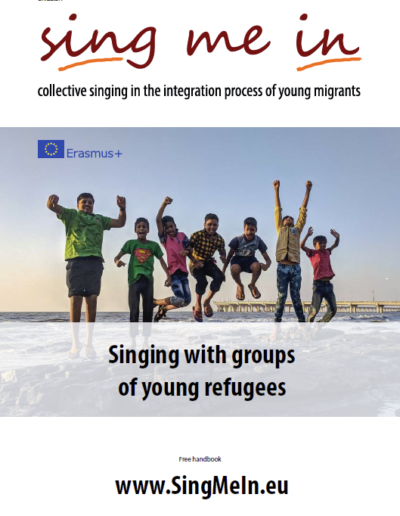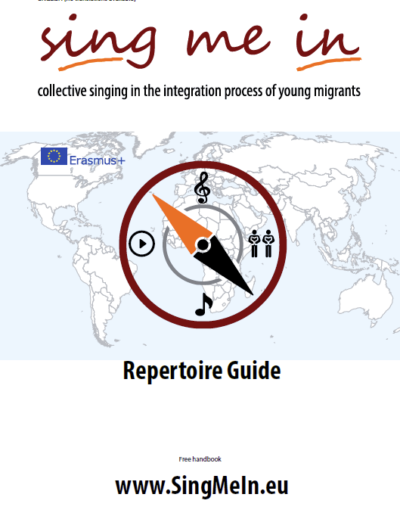Sing Me In – Collective Singing in the Integration Process of Young Migrants
Collective singing is a great tool to help the integration of people from different cultures and backgrounds. We developped 4 handbooks to help you set up your own projects in different contexts.
The handbooks are free and can be downloaded in 11 languages.
Sing me In is a Strategic Partnership coordinated by the European Choral Association – Europa Cantat in cooperation with 10 other organisations from 9 other European countries with the support of the EU Erasmus Plus – Youth Programme.
The project is also referenced as “Good practice example” on the Erasmus+ Results Platform.

Learn more about the project
Crossing lines, daring to try something new, this is an exciting challenge when it is only about music or work methods. And it is easier if you get a little help from your friends. But some people are forced by the circumstances to cross more serious lines, to pass borders, leaving one’s homeland and culture; and to try to start a new life in a foreign country, in a new cultural environment which includes different food, different music, and using different social rules. They also certainly need a little help from friends.
Many young people in different European countries are confronted with these challenges. They risk being excluded due to their socio-economic origin, because of the neighbourhood they live in, because of migration backgrounds, because of their religion, etc. Of course, this issue started long before the last migration episode, triggering a lot of initiatives from all the sectors of civil society. We strongly believe that the world of collective singing can and should play a role in this integration process.
The “Sing Me In” project aims at providing children and youth choir conductors and music teachers with pedagogical approaches and tools that allow collective singing activities to play a positive role in the integration process of young people.
A number of choral organisations expressed their need for structured tools to address the issues at hand: they share the same challenges and are only partially aware of the solutions developed in the other European countries. Yet, most organisations do not have the resources to research and develop solutions at the national level, and it would likely lead to duplicating the effort in each country. As a European network with a long-standing experience in cooperation projects, we decided to address these needs at the European level, to ensure that the whole sector and as many young targets as possible can benefit from it in Europe.
The project gathers 11 musical organisations involved in youth work in 10 countries including Turkey and Lebanon. They will join forces and use their extensive networks to collect good practices related to the use of collective singing in the process of inclusion of young migrants in their respective professional and geographical areas.
The project will evaluate the existing experience to extract best practices, and use this basis to collectively develop innovative pedagogical contents. It will also gather examples of challenges encountered in projects aiming at the inclusion of young migrants, collecting “tips and tricks” and pitfalls to be avoided.
The main outputs of the project will thus be three practical handbooks targeting children and youth choir conductors and music teachers:
- Singing with groups of young refugees
- Including young people with migrant background in existing choirs
- Working in a school environment
They’ll be available in 11 languages, and freely downloadable.
The repertoire guide
Another innovative tool will be a carefully curated collection of repertoire reflecting the migrant’s cultural background to allow for musical exchange between the young singers, accompanied with video sources, sound files, transliterations and translations, pronunciation files to help conductors implement inclusion using relevant material.
We organised a test training and a number of conferences and workshops to disseminate the results of the project and reach out to active practitioners that will in turn use and spread the methods and output further.
If we are to believe anthropology, the human voice was likely amongst the first instruments used by humans to produce music together and it helped members of a group to develop their skills, share emotions, organise common life and provide a sense of belonging. The “Sing Me In” project thus relies on a multi millenary tradition to look into the future and offer innovative and effective tools to help young people to meet without prejudices, acquire skills and enter a productive and balanced relation with the community. And we believe that through this journey across cultures, we can also learn a valuable lesson in how to reach out to these 95% of the European population who are not yet singing in choirs. With a little help from our new friends.
Check our presentation videos
Download the free handbooks!
If you are conductors, singers, teachers, social workers, or any other person interested in using collective singing as a tool for integration, please download our free handbooks. We hope you’ll find useful ideas that will help you developp your own specific projects.
The handbooks
The 3 handbooks were written in English. Translations are available in 10 additional languages below.
English
These are the reference versions in English
- Singing with groups of young refugees (or read online)
- Including young people with migrant background in existing choirs (or read online)
- Working in a school environment (or read online)
And in English only:
Other languages
Arabic |
Catalan |
Dutch |
Estonian |
Finnish |
French |
German |
Norwegian |
Spanish |
Turkish |
Repertoire Guide: the database
On the Musica choral database, you will find additional repertoire and accompanying material, like pronunciation files, transliterations, scores, etc. for a curated selection of songs. You can find them by using the keyword singmein in the search engine.
Direct link
Repertoire Guide: the videos
A set of videos was created during a sepcial work session in Girona. These are mainly musical games, icebreakers and simple songs that can be used in the frame of your project. You will find below the Youtube playlist.
Download the repertoire guide for more information.
Additional resources
We founde other interesting resources along the project:
The partners
The project is coordinated by the European Choral Association in partnership with:
|
Estonian Choral Association (EE) www.kooriyhing.ee |
A Coeur Joie (FR) www.choralies.org |
|
Sulasol (FI) www.sulasol.fi |
Musica International (FR) www.musicanet.org |
|
Ung i Kor (NO) www.ungikor.no |
Moviment Coral Català (CAT/ES) www.mcc.cat |
|
ZIMIHC (NL) www.zimihc.nl |
Koro Kulturu Dernegi (TR) www.korokulturu.org |
|
Koor&Stem (BE) www.koorenstem.be |
Fayha Choir (LB) www.fayhachoir.org |
List of contributors
A lot of people contributed to this project, herebelow are the names of just a few of them, who either wrote, proofread, tested, contributed, translated the handbooks, or provided any other valuable input or help.
We are not listing here the many people who have been experimenting, developing methods that have inspired us, the list would be too long. But they are the real heroes of this project, and their main inspirators.
Emir Akın
Helen Allikvee
Karam Alzouhir
Nidal Aras
Ester Bonal
Marjolein Braspenningx
Pınar Çanakçı
Ruby De Bruyne
Burak Onur Erdem
Ingvill Espedal
Côme Ferrand Cooper
Sonja Greiner
Tom Johnson
Külli Kaats
Işıl Karaelmas Erdem
Lucille Lamaker
Gautier Lemoine
Giulia Lodi
Hanne Orrenmaa
Olav Øyehaug Opsvik
Pierre-Luc Pfrimmer
Jonathan Ploeg
Flannery Ryan
Liesbeth Segers
Fatma Racha Shehadeh
Sara Sloan
Marius Solevaagseide
Beate Sollie Horn
Martine Spanjers
Lizet Spijker
Raffi Taslakian
Çağlar Tosunoğlu
Daniel Z. von Gertten
Jean Claude Wilkens




